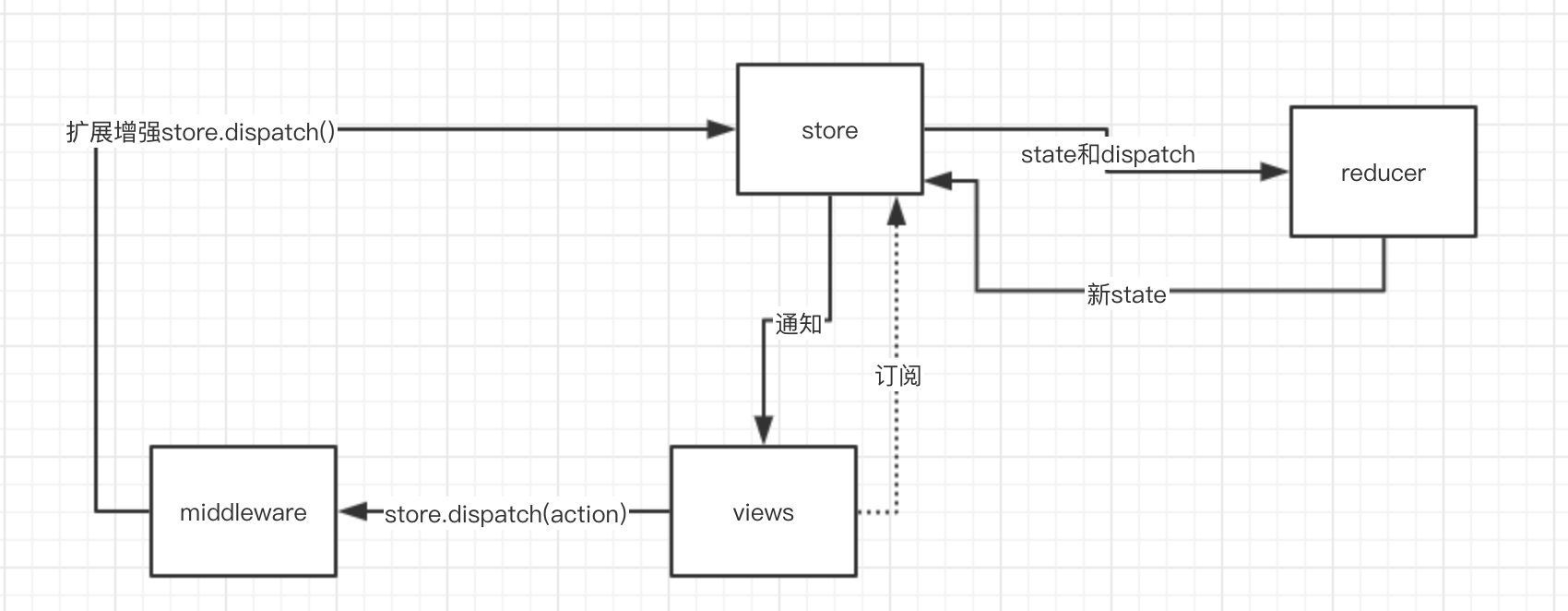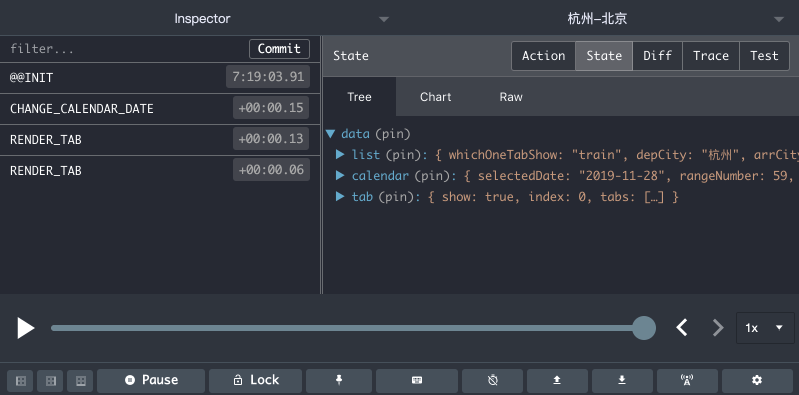学习和理解 Redux提供可预测性的状态管理
 |
|
 2019-05-17
2019-05-17
{ type: 'LIKE_ARTICLE', articleId: 42 } { type: 'FETCH_USER_SUCCESS', response: { id: 3, name: 'Mary' } } { type: 'ADD_TODO', text: '金融前端.' }
export { createStore, combineReducers, bindActionCreators, applyMiddleware, compose, __DO_NOT_USE__ActionTypes }
export default function createStore(reducer, preloadedState, enhancer) { ... }
/** * Reads the state tree managed by the store. * * @returns {any} The current state tree of your application. */ function getState() { if (isDispatching) { throw new Error( 'You may not call store.getState() while the reducer is executing. ' + 'The reducer has already received the state as an argument. ' + 'Pass it down from the top reducer instead of reading it from the store.' ) } return currentState }
/** * Turns an object whose values are different reducer functions, into a single * reducer function. It will call every child reducer, and gather their results * into a single state object, whose keys correspond to the keys of the passed * reducer functions. */ export default function combineReducers(reducers) { const reducerKeys = Object.keys(reducers) ... return function combination(state = {}, action) { ... let hasChanged = false const nextState = {} for (let i = 0; i < finalReducerKeys.length; i++) { const key = finalReducerKeys[i] const reducer = finalReducers[key] const previousStateForKey = state[key] const nextStateForKey = reducer(previousStateForKey, action) if (typeof nextStateForKey === 'undefined') { const errorMessage = getUndefinedStateErrorMessage(key, action) throw new Error(errorMessage) } nextState[key] = nextStateForKey //判断state是否发生改变 hasChanged = hasChanged || nextStateForKey !== previousStateForKey } //根据是否发生改变,来决定返回新的state还是老的state return hasChanged ? nextState : state } }
从源码可以知道,入参是 Reducers,返回一个function。combineReducers就是将所有的 Reducer合并成一个大的 Reducer 函数。核心关键的地方就是每次 Reducer 返回新的state的时候会和老的state进行对比,如果发生改变,则hasChanged为true,触发页面更新。反之,则不做处理。
4、bindActionCreators.js
/** * Turns an object whose values are action creators, into an object with the * same keys, but with every function wrapped into a `dispatch` call so they * may be invoked directly. This is just a convenience method, as you can call * `store.dispatch(MyActionCreators.doSomething())` yourself just fine. */ function bindActionCreator(actionCreator, dispatch) { return function() { return dispatch(actionCreator.apply(this, arguments)) } } export default function bindActionCreators(actionCreators, dispatch) { if (typeof actionCreators === 'function') { return bindActionCreator(actionCreators, dispatch) } ... ... const keys = Object.keys(actionCreators) const boundActionCreators = {} for (let i = 0; i < keys.length; i++) { const key = keys[i] const actionCreator = actionCreators[key] if (typeof actionCreator === 'function') { boundActionCreators[key] = bindActionCreator(actionCreator, dispatch) } } return boundActionCreators }
bindActionCreator是将单个actionCreator绑定到dispatch上,bindActionCreators就是将多个actionCreators绑定到dispatch上。
bindActionCreator就是将发送actions的过程简化,当调用这个返回的函数时就自动调用dispatch,发送对应的action。
bindActionCreators根据不同类型的actionCreators做不同的处理,actionCreators是函数就返回函数,是对象就返回一个对象。主要是将actions转化为dispatch(action)格式,方便进行actions的分离,并且使代码更加简洁。
5、compose.js
/** * Composes single-argument functions from right to left. The rightmost * function can take multiple arguments as it provides the signature for * the resulting composite function. * * @param {...Function} funcs The functions to compose. * @returns {Function} A function obtained by composing the argument functions * from right to left. For example, compose(f, g, h) is identical to doing * (...args) => f(g(h(...args))). */ export default function compose(...funcs) { if (funcs.length === 0) { return arg => arg } if (funcs.length === 1) { return funcs[0] } return funcs.reduce((a, b) => (...args) => a(b(...args))) }
compose是函数式变成里面非常重要的一个概念,在介绍compose之前,先来认识下什么是 Reduce?官方文档这么定义reduce:reduce()方法对累加器和数组中的每个元素(从左到右)应用到一个函数,简化为某个值。compose是柯里化函数,借助于Reduce来实现,将多个函数合并到一个函数返回,主要是在middleware中被使用。
6、applyMiddleware.js
/** * Creates a store enhancer that applies middleware to the dispatch method * of the Redux store. This is handy for a variety of tasks, such as expressing * asynchronous actions in a concise manner, or logging every action payload. */ export default function applyMiddleware(...middlewares) { return createStore => (...args) => { const store = createStore(...args) ... ... return { ...store, dispatch } } }
applyMiddleware.js文件提供了middleware中间件重要的API,middleware中间件主要用来对store.dispatch进行重写,来完善和扩展dispatch功能。
那为什么需要中间件呢?
首先得从Reducer说起,之前 Redux三大原则里面提到了reducer必须是纯函数,下面给出纯函数的定义:
- 对于同一参数,返回同一结果
- 结果完全取决于传入的参数
- 不产生任何副作用
至于为什么reducer必须是纯函数,可以从以下几点说起?
- 因为 Redux 是一个可预测的状态管理器,纯函数更便于 Redux进行调试,能更方便的跟踪定位到问题,提高开发效率。
- Redux 只通过比较新旧对象的地址来比较两个对象是否相同,也就是通过浅比较。如果在 Reducer 内部直接修改旧的state的属性值,新旧两个对象都指向同一个对象,如果还是通过浅比较,则会导致 Redux 认为没有发生改变。但要是通过深比较,会十分耗费性能。最佳的办法是 Redux返回一个新对象,新旧对象通过浅比较,这也是 Reducer是纯函数的重要原因。
Reducer是纯函数,但是在应用中还是会需要处理记录日志/异常、以及异步处理等操作,那该如何解决这些问题呢?
这个问题的答案就是中间件。可以通过中间件增强dispatch的功能,示例(记录日志和异常)如下:
const store = createStore(reducer); const next = store.dispatch; // 重写store.dispatch store.dispatch = (action) => { try { console.log('action:', action); console.log('current state:', store.getState()); next(action); console.log('next state', store.getState()); } catch (error){ console.error('msg:', error); } }
五、从零开始实现一个简单的Redux
既然是要从零开始实现一个Redux(简易计数器),那么在此之前我们先忘记之前提到的store、Reducer、dispatch等各种概念,只需牢记Redux是一个状态管理器。
首先我们来看下面的代码:
let state = { count : 1 } //修改之前 console.log (state.count); //修改count的值为2 state.count = 2; //修改之后 console.log (state.count);
我们定义了一个有count字段的state对象,同时能输出修改之前和修改之后的count值。但此时我们会发现一个问题?就是其它如果引用了count的地方是不知道count已经发生修改的,因此我们需要通过订阅-发布模式来监听,并通知到其它引用到count的地方。因此我们进一步优化代码如下:
let state = { count: 1 }; //订阅 function subscribe (listener) { listeners.push(listener); } function changeState(count) { state.count = count; for (let i = 0; i < listeners.length; i++) { const listener = listeners[i]; listener();//监听 } }
此时我们对count进行修改,所有的listeners都会收到通知,并且能做出相应的处理。但是目前还会存在其它问题?比如说目前state只含有一个count字段,如果要是有多个字段是否处理方式一致。同时还需要考虑到公共代码需要进一步封装,接下来我们再进一步优化:
const createStore = function (initState) { let state = initState; //订阅 function subscribe (listener) { listeners.push(listener); } function changeState (count) { state.count = count; for (let i = 0; i < listeners.length; i++) { const listener = listeners[i]; listener();//通知 } } function getState () { return state; } return { subscribe, changeState, getState } }
我们可以从代码看出,最终我们提供了三个API,是不是与之前Redux源码中的核心入口文件index.js比较类似。但是到这里还没有实现Redux,我们需要支持添加多个字段到state里面,并且要实现Redux计数器。
let initState = { counter: { count : 0 }, info: { name: '', description: '' } } let store = createStore(initState); //输出count store.subscribe(()=>{ let state = store.getState(); console.log(state.counter.count); }); //输出info store.subscribe(()=>{ let state = store.getState(); console.log(`${state.info.name}:${state.info.description}`); });
通过测试,我们发现目前已经支持了state里面存多个属性字段,接下来我们把之前changeState改造一下,让它能支持自增和自减。
//自增 store.changeState({ count: store.getState().count + 1 }); //自减 store.changeState({ count: store.getState().count - 1 }); //随便改成什么 store.changeState({ count: 金融 });
我们发现可以通过changeState自增、自减或者随便改,但这其实不是我们所需要的。我们需要对修改count做约束,因为我们在实现一个计数器,肯定是只希望能进行加减操作的。所以我们接下来对changeState做约束,约定一个plan方法,根据type来做不同的处理。
function plan (state, action) => { switch (action.type) { case 'INCREMENT': return { ...state, count: state.count + 1 } case 'DECREMENT': return { ...state, count: state.count - 1 } default: return state } } let store = createStore(plan, initState); //自增 store.changeState({ type: 'INCREMENT' }); //自减 store.changeState({ type: 'DECREMENT' });
我们在代码中已经对不同type做了不同处理,这个时候我们发现再也不能随便对state中的count进行修改了,我们已经成功对changeState做了约束。我们把plan方法做为createStore的入参,在修改state的时候按照plan方法来执行。到这里,恭喜大家,我们已经用Redux实现了一个简单计数器了。
这就实现了 Redux?这怎么和源码不一样啊
然后我们再把plan换成reducer,把changeState换成dispatch就会发现,这就是Redux源码所实现的基础功能,现在再回过头看Redux的数据流图是不是更加清晰了。

六、Redux Devtools
Redux devtools是Redux的调试工具,可以在Chrome上安装对应的插件。对于接入了Redux的应用,通过 Redux devtools可以很方便看到每次请求之后所发生的改变,方便开发同学知道每次操作后的前因后果,大大提升开发调试效率。

如上图所示就是 Redux devtools的可视化界面,左边操作界面就是当前页面渲染过程中执行的action,右侧操作界面是State存储的数据,从State切换到action面板,可以查看action对应的 Reducer参数。切换到Diff面板,可以查看前后两次操作发生变化的属性值。
七、总结
Redux 是一款优秀的状态管理器,源码短小精悍,社区生态也十分成熟。如常用的react-redux、dva都是对 Redux 的封装,目前在大型应用中被广泛使用。这里推荐通过 Redux官网以及源码来学习它核心的思想,进而提升阅读源码的能力。
编辑:航网科技 来源:腾讯云代理 本文版权归原作者所有 转载请注明出处
 微信扫一扫关注我们
微信扫一扫关注我们

